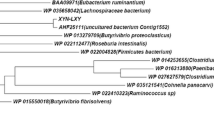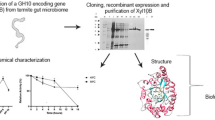Abstract
The gene encoding xylanase activity in the ruminal bacteriumBacteroides ruminicola D31d was cloned and expressed inEscherichia coli with the plasmid vector pUC18. The gene was isolated on a 4.7-kilobase pair partialPstI genomic DNA fragment. The xylanase activity expressed inE. coli was cell associated and could degrade both oatspelt xylan and Remazol Brilliant Blue-xylan. The xylanase did not have detectable activity against carboxymethylcellulose. Utilization of an endogenous promoter byE. coli was indicated by expression of xylanase activity after subcloning of the insert into pBR322 in opposite orientations. TheB. ruminicola D31d xylanase gene was compared by Southern hybridization analyses with xylanase genes cloned fromB. ruminocola 23 andB. ovatus V975, a human intestinal isolate. The D31d xylanase gene did not cross-hybridize with either of the other two genes. In addition, the 23 xylanase gene did not cross-hybridize with the other two genes according to the same technique. These results indicate that the three cloned genes do not share a high degree of genetic similarity, despite the similar enzymatic activities. This is the first study to compare cloned genes from ruminal and colonicBacteroides species.
Similar content being viewed by others
Literature Cited
Boyer HW, Roulland-Dussoix D (1969) A complementation analysis of the restriction and modification of DNA inEscherichia coli. J Mol Biol 41:459–464
Bradford MM (1976) A rapid and sensitive method for the quantitation of microgram quantities of protein utilizing the principle of protein-dye binding. Anal Biochem 72:248–254
Bryant MP, Small N, Bouma C, Chu H (1958)Bacteroides ruminicolan. sp. andSuccinimonas amylolytica the new genus and species. Species of succinic acid-producing anaerobic bacteria of the rumen. J Bacteriol 76:15–23
Dehority BA (1969) Pectin-fermenting bacteria isolated from the bovine rumen. J Bacteriol 99:189–196
Hespell RB, Wolf R, Bothast RJ (1987) Fermentation of xylans byButyrivibrio fibrisolvens and other ruminal bacteria. Appl Environ Microbiol 53:2849–2853
Laemmli UK (1970) Cleavage of structural proteins during the assembly of the head of bacteriophage T4. Nature (London) 227:680–685
Maniatis T, Fritsch EF, Sambrook J (1982) Molecular cloning: a laboratory manual. Cold Spring Harbor, New York: Cold Spring Harbor Laboratory
Mannarelli BM (1988) Deoxyribonucleic acid relatedness among strains of the speciesButyrivibrio fibrisolvens. Int J Syst Bacteriol 23:308–315
Mannarelli BM, Stack RJ, Lee D, Ericsson L (1990) Taxonomic relatedness ofButyrivibrio, Lachnospira, Roseburia, andEubacterium species as determined by DNA hybridization and extracellular-polysaccharide analysis. Int J Syst Bacteriol 40:535–544
Morelle G (1989) A plasmid extraction procedure on a miniprep scale. BRL Focus 11:7–8
Paster BJ, Ludwig W, Weisburg WG, Stackebrandt W, Hespell RB, Hahn CM, Reichenbach E, Stetter KO, Woese CR (1985) A phylogenetic grouping of the bacteroides, cytophagas, and certain flavobacteria. Syst Appl Microbiol 6:34–42
Saito H, Miura H (1963) Preparation of transforming deoxyribonucleic acid by phenol treatment. Biochim Biophys Acta 72:619–629
Salyers AA, Vercellotti JR, West SEH, Wilkins TD (1977) Fermentation of mucin and plant polysaccharides by strains ofBacteroides from the human colon. Appl. Environ Microbiol 33:319–322
Salyers AA, Gheridini F, O'Brien M (1981) Utilization of xylan by two species of human colonicBacteroides. Appl Environ Microbiol 41:1065–1068
Salyers AA, Balascio JR, Palmer JR (1982) Breakdown of xylan by enzymes from human colonic bacteria. J Food Biochem 6:39–55
Southern EM (1975) Detection of specific sequences among DNA fragments separated by gel electrophoresis. J Mol Biol 98:503–517
Whitehead TR, Hespell RB (1989) Cloning and expression inEscherichia coli of a xylanase gene fromBacteroides ruminicola 23. Appl Environ Microbiol 55:893–896
Whitehead TR, Hespell RB (1990) The genes for three xylan-degrading activities fromBacteroides ovatus are clustered in a 3.8-kilobase region. J Bacteriol 172:2408–2412
Yang RCA, MacKenzie CR, Bilous D, Narang SA (1989) Hyperexpression of aBacillus circulans xylanase gene inEscherichia coli and characterization of the gene product. Appl Environ Microbiol 55:1192–1195
Yanisch-Perron C, Vieira J, Messing J (1985) Improved M13 phage cloning vectors and host vectors: nucleotide sequences of the M13mp18 and pUC19 vectors. Gene 33:103–119
Author information
Authors and Affiliations
Additional information
The mention of firm names or trade products does not imply that they are endorsed or recommended by the U.S. Department of Agriculture over other firms or similar products not mentioned.
Rights and permissions
About this article
Cite this article
Whitehead, T.R., Lee, D.A. Cloning and comparison of xylanase genes from ruminal and colonicBacteroides species. Current Microbiology 23, 15–19 (1991). https://doi.org/10.1007/BF02092303
Issue Date:
DOI: https://doi.org/10.1007/BF02092303




